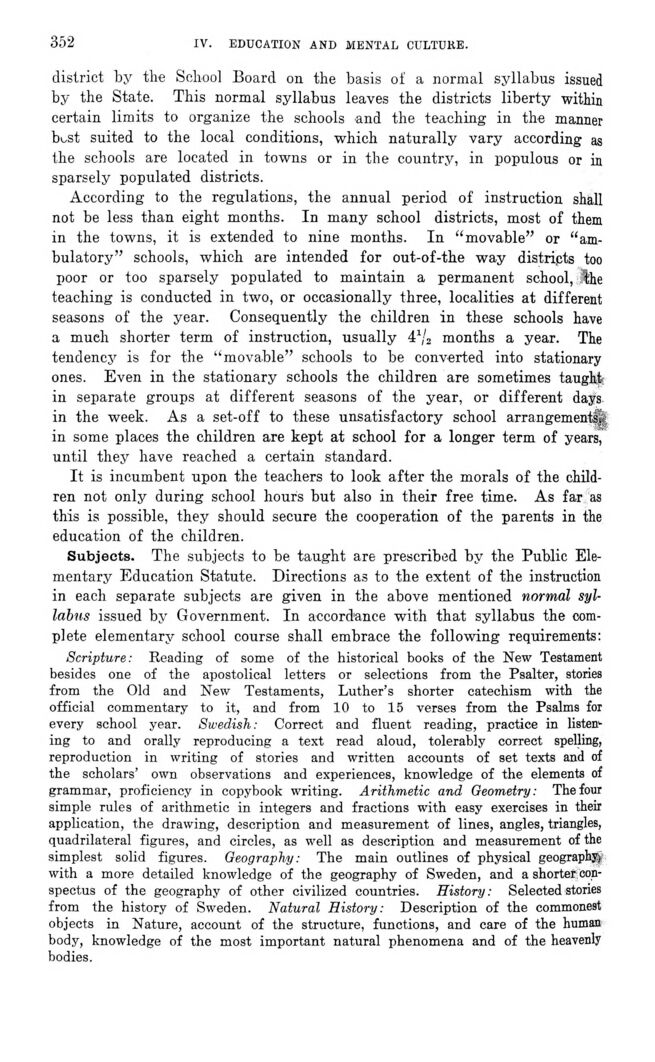
Full resolution (JPEG) - On this page / på denna sida - IV. Education and Mental Culture. Introd. by P. E. Lindström - 1. Elementary Education. By J. M. Ambrosius

<< prev. page << föreg. sida << >> nästa sida >> next page >>
Below is the raw OCR text
from the above scanned image.
Do you see an error? Proofread the page now!
Här nedan syns maskintolkade texten från faksimilbilden ovan.
Ser du något fel? Korrekturläs sidan nu!
This page has never been proofread. / Denna sida har aldrig korrekturlästs.
352
iv. education and mental culture.
district by the School Board on the basis of a normal syllabus issued
by the State. This normal syllabus leaves the districts liberty within
certain limits to organize the schools and the teaching in the manner
b^st suited to the local conditions, which naturally vary according as
the schools are located in towns or in the country, in populous or in
sparsely populated districts.
According to the regulations, the annual period of instruction shall
not be less than eight months. In many school districts, most of them
in the towns, it is extended to nine months. In "movable" or
"ambulatory" schools, which are intended for out-of-the way districts too
poor or too sparsely populated to maintain a permanent school, the
teaching is conducted in two, or occasionally three, localities at different
seasons of the year. Consequently the children in these schools have
a much shorter term of instruction, usually 41/2 months a year. The
tendency is for the "movable" schools to be converted into stationary
ones. Even in the stationary schools the children are sometimes taught
in separate groups at different seasons of the year, or different days,
in the week. As a set-off to these unsatisfactory school arrangements,
in some places the children are kept at school for a longer term of years,
until they have reached a certain standard.
It is incumbent upon the teachers to look after the morals of the
children not only during school hours but also in their free time. As far as
this is possible, they should secure the cooperation of the parents in the
education of the children.
Subjects. The subjects to be taught are prescribed by the Public
Elementary Education Statute. Directions as to the extent of the instruction
in each separate subjects are given in the above mentioned normal
syllabus issued by Government. In accordance with that syllabus the
complete elementary school course shall embrace the following requirements:
Scripture: Reading of some of the historical books of the New Testament
besides one of the apostolical letters or selections from the Psalter, stories
from the Old and New Testaments, Luther’s shorter catechism with the
official commentary to it, and from 10 to 15 verses from the Psalms for
every school year. Swedish: Correct and fluent reading, practice in listen^
ing to and orally reproducing a text read aloud, tolerably correct spelling,
reproduction in writing of stories and written accounts of set texts and of
the scholars’ own observations and experiences, knowledge of the elements of
grammar, proficiency in copybook writing. Arithmetic and Geometry: The four
simple rules of arithmetic in integers and fractions with easy exercises in their
application, the drawing, description and measurement of lines, angles, triangles,
quadrilateral figures, and circles, as well as description and measurement of the
simplest solid figures. Geography: The main outlines of physical geography,
with a more detailed knowledge of the geography of Sweden, and a shorter
conspectus of the geography of other civilized countries. History: Selected stories
from the history of Sweden. Natural History: Description of the commonest
objects in Nature, account of the structure, functions, and care of the human
body, knowledge of the most important natural phenomena and of the heavenly
bodies.
<< prev. page << föreg. sida << >> nästa sida >> next page >>